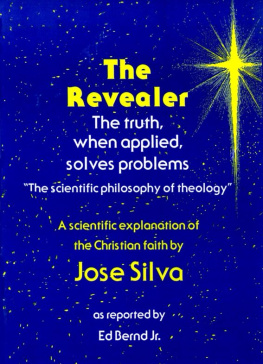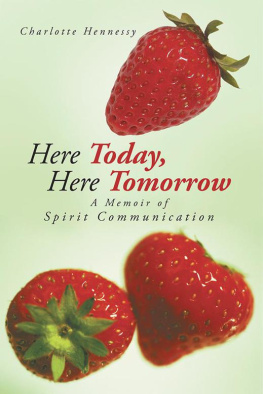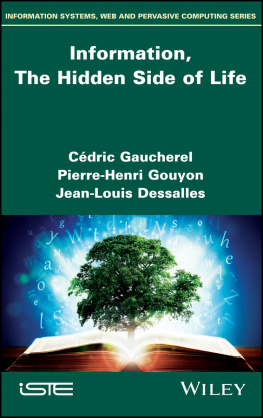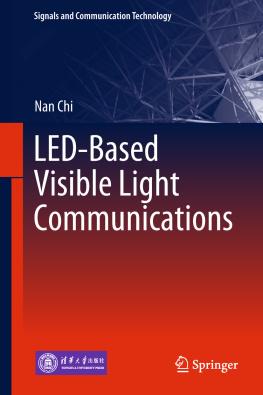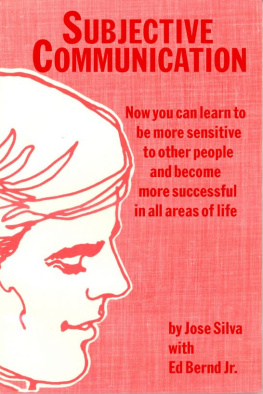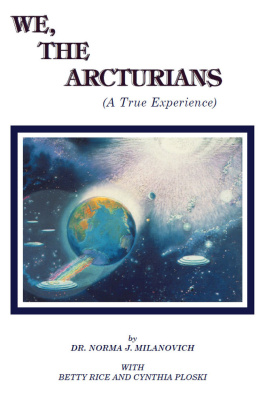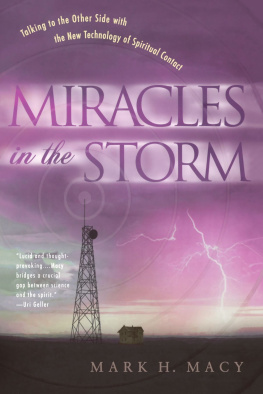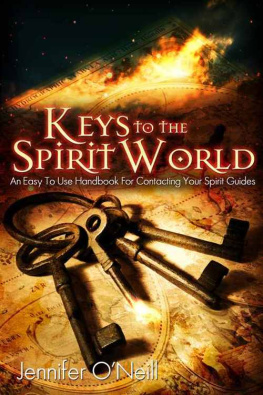CONVERSATIONS BEYOND THE LIGHT
COMMUNICATION WITH DEPARTED FRIENDS
& COLLEAGUES BY ELECTRONIC MEANS
DR. PAT KUBIS and MARK MACY
Published by Griffin Publishing in conjunction with
Continuing Life Research
Boulder, Colorado
COPYRIGHT
1995 by Mark Macy and Pat Kubis, and in conjunction with Griffin Publishing.
All Rights Reserved. No part of this publication may be reproduced, stored in a retrieval system, or transmitted, in any form or by means electronic, mechanical, photocopying, recording, or otherwise, except for the inclusion of brief quotations in a review, without prior permission in writing from the publisher.
Book design: Mark M. Dodge Copy editor: Dina Falls Photo editor: Robin Howland Typesetting: Regina Books Production supervision: Larry Davis
10987654321
ISBN 1-882180-47-X
The photographs, text, transcripts and stories have been supplied by the authors who are solely responsible for their accuracy. The views and beliefs expressed herein are not necessarily those of the publisher or his staff.

Published by Griffin Publishing in conjunction with
Continuing Life Research P.O. Box 11036 Boulder, CO 80301 USA
Manufactured in the United States of America
CONTENTS
Introduction vii
Prologue 1
1 The World of the Dead 5
2 Two Children on the Third Plane 23
3 Forever Sweethearts 35
4 The Third Plane 49
5 Jacob's Ladder 63
6 Reincarnation and the Consequences of Abortion 77
7 Heaven and Hell 87
8 Instrumental Transcommunication 103
9 Purpose of Timestream Lab and CETL (Luxembourg Lab) 121
10 Getting Started 127
11 The Latest Spirit Contacts in Luxembourg 137
Photo Section 149
Bibliography 163
About the Authors 167
Back Cover
Introduction
After first grasping the idea of death, young children often ask a variant of the question: "What happens after we die?" Parents are usually at a loss about how to answer, since they have not yet arrived at their own answer. Every culture, every generation, every individual wants to know the answer to: "If a man dies, shall he live again?" Even the space capsule sent by NASA out beyond our solar system contained questions asking possible other inhabitants of our universe if they had found an answer to the question of death.
The relevance of this question becomes apparent when we consider our life's purpose and the limited time we have to fulfill it. Does our consciousness come into existence only to be snuffed out at the end of our lifespan? Or are there levels or cycles of existence beyond the present "reality" which continue or carry further our earthly endeavors? If so, then every thought and action has meaning far beyond the present.
The advent of modern science led to the Enlightenment period of the 17th century and the belief that all problems could be solved by either reason or the scientific method. Galileo asked the Church fathers to look through his telescope and trust their five senses rather than to blindly believe church doctrine which held that earth is the center of our solar system. This empirical method of proof, i.e. posing a hypothesis and, with strict controls, guiding the experiment to its unbiased results, alas, led the Western mind to doubt all experiences not provable in this manner.
Yet always there were some who experienced events unexplainable by science or so-called rational thinking. The mystical union, the one-ness, experienced by Christian mystics, the Sufis of Islam, Native American Shamans, and described in the Jewish Kabala, cannot easily be dismissed. When Buddha admonished his followers to not unquestioningly accept his teachings, but to trust their experience, he was referring to not just the five senses, but also humans' inner, subjective experiences. These inner experiences of dimensions beyond our earthly life, while anecdotal, were until recently not verifiable by traditional methods. Our authors have taken on a task which clearly necessitates what physicist Thomas Kuhn calls the "new paradigm," i.e. to look at events from a whole new perspective, and in the authors' case explore the soul's transcendence beyond this earthly life of human consciousness.
The authors and the psychic laboratories they collaborated with, presented their findings with the help of sophisticated electronic equipment not available previously. Skeptics also object to reports of different kinds of so-called near-death-experience or NDE, first reported by Raymond Moody, M.D. While the majority of individuals declared clinically dead are transported through a tunnel toward a white light, others take a different, and some even extremely frightening journey. Likewise throughout the years, other realms of existence have been variously described by those who had them, as heaven or hell, nirvana or purgatory, bliss or the place of a thousand wrathful gods.
These disparate accounts added fuel to the fire of skeptics. However, the authors of Conversations Beyond the Light present a fresh point of view by describing the astral plane as multi-dimensional, consisting of seven levels. This helps us understand the varieties of near-death experiences described in the literature over the last twenty years. It also gives us a better understanding of the many different descriptions and messages of those souls who are able to communicate with relatives and friends on this earthly plane.
Many volumes have been written about people able to contact spirit guides, are channelers, or give psychic readings. From the reports and experiences of the authors it appears that all of them could be true because of the much broader, multi-dimensional views given us by Mark Macy and Pat Kubis. In a foreword to W. Y. Evans-Wentz translation of Tibetan Book of the Dead, Lama Anagarika Govinda says:
There is not one person, indeed, not one living being, that has not returned from death. In fact, we all have died many deaths, before we came into this incarnation. And what we call birth is merely the reverse side of death, like one of the two sides of a coin, or like a door which we call "entrance" from outside and "exit", from inside a room....It is much more astonishing that not everyone remembers his or her previous death; and, because of this lack of remembering, most persons do not believe there was a previous death. But likewise, they do not remember their recent birth and yet they do not doubt that they were recently born.
While until the recent past only the rare visionary delved into the realms our authors refer to as "beyond the light," interest in these transpersonal dimensions now comes from many quarters. And best of all, Macy and Kubis offer their readers a concrete method by which they can explore for themselves realms that proved until now too difficult to explore.
Elton Davis, Ed.D.
Professor Emeritus
Pasadena City College
Prologue
In 1976 , the great yogi Sant Keshavadas casually remarked at a lecture in India that by the end of the century, we would be able to pick up a phone and "call" friends, loved ones, and colleagues who have died.
Even before that, in 1936 , theosophist Alice Bailey predicted that those who had passed over will communicate with Earth and this communication will be "reduced to a true science.... Death will lose its terrors, and that particular fear will come to an end." 1 Today, in Luxembourg, and in many countries all over the world, the prophecies of Bailey and Sant Keshavadas have come true.
1 Handbook of PSI Discoveries by Sheila Ostrander & Lynn Schroeder, Berkeley Publishing Corp., p.264.
Next page

